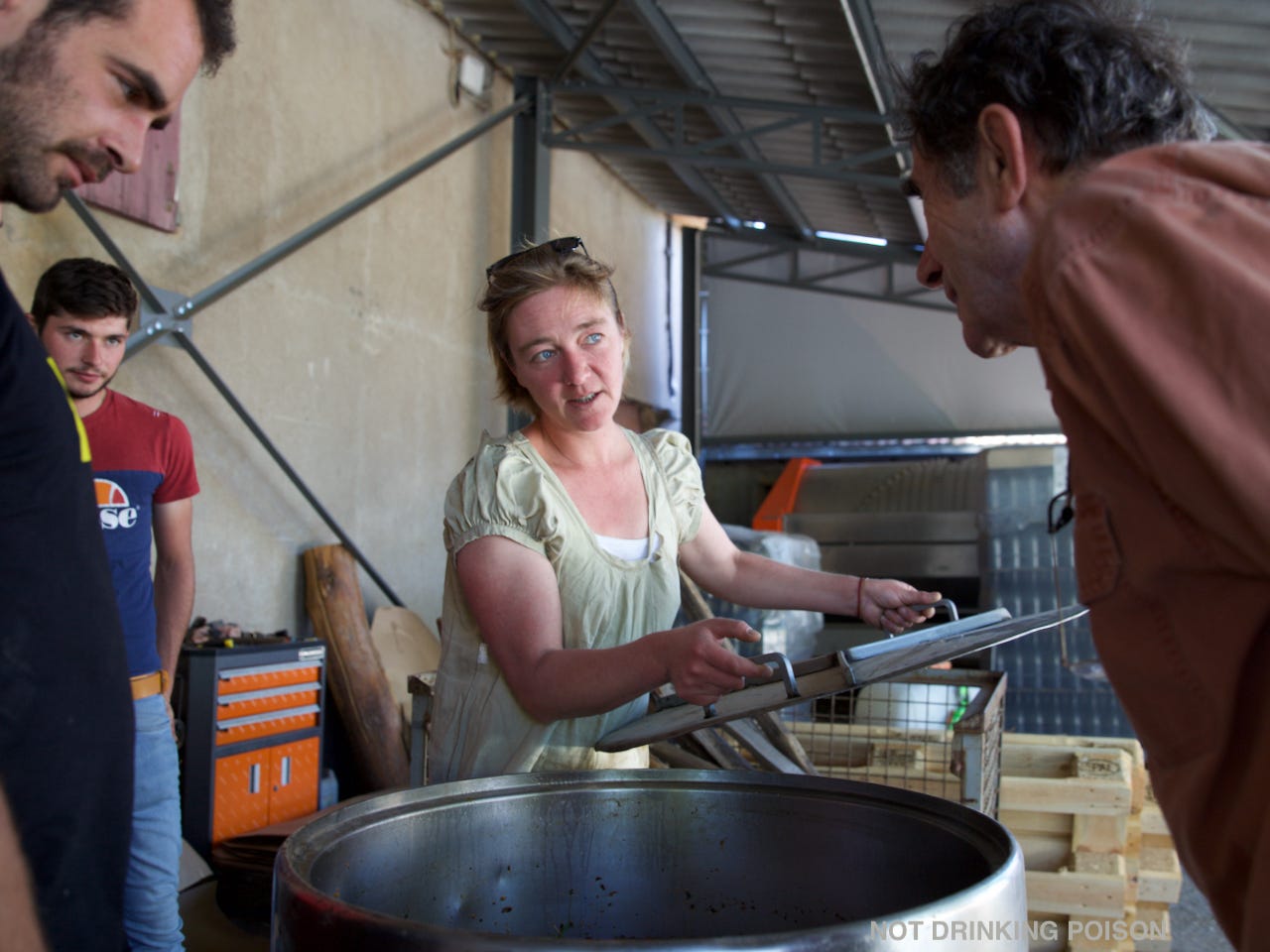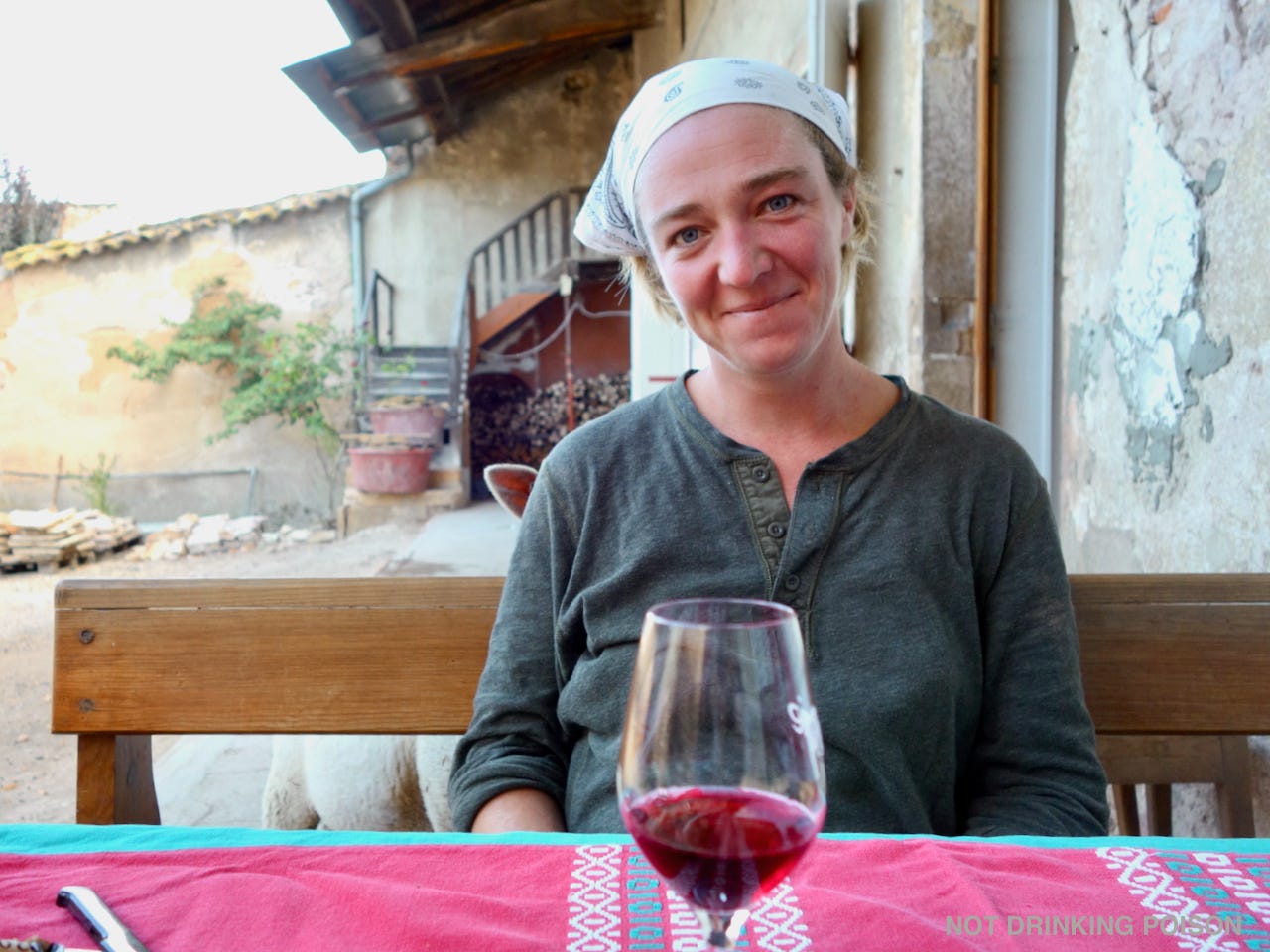Remembering Julie Balagny
An archive interview with the sensational and inspirational Fleurie vigneronne, who passed away suddenly on Saturday.
Internationally-beloved Fleurie vigneronne Julie Balagny passed away suddenly on July 1st at the age of forty-five. The cause was a heart attack, which occurred in the painfully novelistic circumstance of the wedding of her half-sister, a cardiologist. As sensational in life as in death, Balagny leaves behind an acclaimed career in which she forged a more radical aesthetic path than that of her stylistic forebears in the Beaujolais, even as her picturesque lifestyle - that of a courageous, independent neo-vigneronne, surrounded by farm animals - helped inspire untold numbers of friends, disciples, and fans.
Balagny moved to the Beaujolais in 2009, acquiring a patch of old-vine Fleurie with the encouragement of appellation luminary Yvon Métras. By the middle of the following decade, she had emerged as a pivotal figure within Beaujolais natural wine culture: its most prominent and acclaimed proponent of cool carbonic maceration with zero sulfite addition. Like the work of her friends Jean-Louis Dutraive and Paul-Henri Thillardon, Balagny’s rosy, soulful gamays tended to unite Lapierre-era classicists and zero-zero radicals alike in admiration.
Among Beaujolais winemakers, Balagny was distinguished as much by her broad knowledge of natural wine culture - refined during her years as winemaker at Nîmes estate Terre des Chardons - as by her origins in the tony Paris suburb of Saint Cloud.
To anyone who asked, Balagny would cheerfully admit to being the black sheep in a family of doctors and ballet dancers. Her ramshackle, fixer-upper farmstead in the hamlet of Moulin-à-Vent, where she lived among actual sheep (and chickens, dogs, ducks, volunteers, and various lost souls), often seemed like an extravagant repudiation of her upbringing. But it also evidenced the genuine, wide-eyed love Balagny felt for her adoptive rural winemaking milieu.
In such a way, she had something in common with natural wine fanatics the world over.
The majority of importers, journalists, cavistes, and sommeliers who came to Balagny’s door were, after all, not born into winegrowing communities. Balagny knew what it was like to be an outsider to such a community - and what it was like to be driven to become an insider. To her everlasting credit, she was always willing to help others down a similar path.
Today, the natural wine world is embroidered with Balagny’s influence. Talented acolytes include Thomas Popy in the Jura; Louis Terral in the Bugey; and in California, Shaunt Oungoulian of Les Lunes, and upstart Bay Area négociant Sam Rogers. Balagny’s commercial partners, meanwhile, were indistinguishable from dear friends. Her kitchen was a beacon of welcome in the Beaujolais to influential figures like Olivier Roblin of Les Caves du Panthéon, Keven Clancy of Farm Wine Imports, Bradford Taylor of Ordinaire, Emil Broomé and Ulf Ringus of Sweden’s Vin & Natur, and many more.
I met Balagny in 2015, back when I was hell-bent on writing a book about the Beaujolais (a project that would evolve into The World of Natural Wine). To whatever extent I have since succeeded as a wine writer, I owe it to Balagny, because when I came to her door that August, she spotted a fellow natural wine fanatic. She found me a place to live in the Beaujolais and introduced me to her friends there. My experiences in the region were to permanently alter my perspective on wine. (Also, probably, my liver.)
Bella ciao, Julie B. Here’s to living free.
In the spirit of remembrance of Julie’s kindness and joie de vivre, I thought I’d share below a heretofore-unreleased 2018 archive interview for subscribers.
JULIE BALAGNY: AN INTERVIEW

This interview was conducted in July 2018. It has been condensed and edited for clarity.
When did you first get into wine?
JULIE BALAGNY: It was in 1999. I was twenty-one. In the summers, I used to work with a cousin whose boyfriend had a big domaine near Perpignan. It was called Château de Caladroy. It was very high up below the Canigou, in the back country. I worked at a little restaurant they had there that was open in the summertime.
I’d already wanted to work in agriculture since I was very young. I didn’t want to be a parisienne, I wanted to do other things. Wine really interested me.
I did a preparatory class for university, where they took the top fifty scorers. I came in 59th. I told my mother and father, “It’s a shame, I failed my test. Not but much, but I failed. So I’ll stop.” And I left. I went to Perpignan, because I had a place to stay there. I found an adult learning course, and I did a BTS [in viticulture].
When was your first vintage in the Beaujolais?
I arrived in January 2009. The first year, I vinified with Yvon [Métras]. I did two cuvées, it was an assemblage that I never did again.
I got hailed very bad that year. My parcel is on a hill; there are about 40 ares slightly in a hollow at the bottom, and the rest is above. The hail devastated the part above, but the vines in the hollow were much less hurt. So I did a cuvée of what was in the hollow, and the rest was “En Remont.”
Had you vinified gamay before moving to the Beaujolais?
I had no experience with gamay before moving to the Beaujolais. That first year, it was cool to be at Yvon [Métras’]. To able to see, in a concrete way, his rhythm and his way of working, which for me is a technique that is extremely simple.
How did the vinification differ from what you practiced in the Languedoc?
Everything was destemmed at Terre des Chardons. I remember near Nîmes, we had difficult equilibriums in the wine, with a very high pH. To make unsulfited wine in Nîmes, the whole question of balance was much more complicated. That’s why Yvon said to me, before I arrived here, “Given the analyses, if you know how to make wine without sulfites down there, it’ll be much simpler up there.”
But there are other problems, too. I hit a few walls, in vinification, that were very instructive.
What was the worst beginner’s error?
The worst beginner’s error… I think there were several. 2009 went very well for me, and 2010 was sensational. Then in 2011, I got taught a lesson.
We did a pretty harvest, almost 30HL/ha. I had done three cuvées in 2010, and it was very coherent. But in 2011 I decided to do four tanks, but with each a little less full. And there you have it, the first error.
I wanted to stay in the schema of the previous year, but it wasn’t the same year, I should have done it differently. I should have made three tanks very very full, and one small tank, very full. Instead I had four big tanks, each filled three-quarters full. It was dumb.
Do you refrigerate the harvest here before vatting?
Essentially I refrigerate [some of the harvest] each year. I don’t have the precision of [Le Ptit] Max or Yvon [Métras] on the temperature. Because I don’t own a fridge. I use refrigeration units either at Jean-Louis Dutraive’s or at Sylvain [Chanudet’s] place. I leave it in there for twenty-four hours, and then I vat. But with the time it takes to transport the harvest back here, it heats up.
Do you ever miss working with grapes other than gamay?
I don’t get bored not making white wine. I don’t get bored not assembling carignan and syrah. I’m really delighted to have chosen the Beaujolais, even with just one varietal to work with. I find it’s crazy that gamay is so transparent.
What’s the toughest thing about life in the Beaujolais?
What is hard to get used to is drinking a glass of white wine at 9AM instead of a coffee.
They’re all alcoholics. We’re all alcoholics. Maybe not all the winemakers. But if you frequent the natural winemakers…
Your wines are on the higher end of pricing for the Beaujolais. Do you sell mostly to export markets, rather than within France?
In 2016, I sold 88% on the export market. It’s the same price. But [importers] pay on time. Not like Parisian restaurateurs, or even the ones in the countryside, for that matter. And they pay when they order. That way they’re sure of getting the wine.
What’s annoying, in all the emerging countries of natural wine, is the inflation of prices. For small winemakers like me, who have very few bottles, the inflation happens very quickly. You have to make sure that the buyer drinks it and doesn’t simply flip it.
You see a bottle of “Cayenne” priced at $150 in New York! When it leaves the winery at 9€ before VAT.
People tell me to raise the prices, because it will diminish the grey market. It’ll help resolve that, but then there will be a whole other part of my clients who can no longer afford the wine. It doesn’t interest me to no longer reach a clientele that has a wallet like my own.
What are your projects for the future? How would you like to see your work improve?
I try to push back the release dates of my wines, so they’ll arrive to clients in a more stable state.
We know how to farm grapes in organics, generally. There are always a few little errors, but overall we know. And in the broad outlines, we know how to make wine without sulfites. But what I find very complicated is the economy. Because the economy is not adapted to any of this.
The notion of time is not what it was twenty years ago. Us, we try to work a little like a previous era, to leave time to time, because wine needs time sometimes. And the economy is no longer adapted to that at all. We need to find solutions to return time to this world that no longer has time.
It happens, necessarily, by keeping a bit more wine back each year, selling it later, putting the brakes on the market. Because time helps wine, I’m persuaded of that. Especially natural wine.
Aging natural wine can certainly be rewarding.
You taste a 1984 Morgon by Marcel Lapierre in, say, April 2015, and you say that it’s starting to get cooked. Then you taste it two years later, and you find that the wine is in full form!
Or in 2009, I went into Yvon’s cellar. We always drank the 1988, the 1989, the 2005, and at a certain point there was no more of those, so we had to find others. Once I went down there and I found a 2004. Yvon says forget it, it’s disgusting, it was a catastrophe, the year of geosmin. And we tasted it in 2009 and it was a bomb, a massacre!
Some other winemakers who showed me a lot are Seb Dervieux and Patrick Desplats. They’d have you taste weird twisted undrinkable things, and you keep them in the cellar two years, and it’s a massacre. Plus, humanly, they’re so nice.
FIN

Julie Balagny, vigneronne.
1978-2023
FURTHER READING
Our friend Bert Celce - on whose blog I first read about Julie Balagny - has put up a nice group of photos in memoriam at Wine Terroirs.
A long, heartfelt tribute to Julie Balagny by Jules Dresnner at Louis/Dressner.
An obituary of Julie Balagny at Rue89Lyon.
An obituary of Julie Balagny at Le Progrès.
An obituary of Julie Balagny by Alicia Dorey at Le Figaro.
Celce’s account of a 2020 visit we paid to Balagny together at Wine Terroirs.
Celce’s beautiful heartbreaking 2011 post on Julie Balagny at Wine Terroirs.
My October 2018 feature on Julie Balagny in Pipette.
My 2015 blog post on Julie Balagny.




❤️❤️❤️